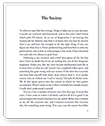Essay Instructions: Raymond Carver??s Description of Small Good Things in his Stories
??E Introduction
It is no secret that Raymond Carver??s writings are filled with muses of despair, discontent, and addiction. And consequently, little is said or written in regard to Carver??s happier content. It does exist. In some stories, I found some healing or harmony. I felt Raymond Carver really wanted to feel the common happiness in daily life, because he spent many years not being able to feel happy and live a kind of miserable life in which he was addicted to alcohol and experienced troubles in his family like his children??s rebellious deeds. Raymond Carver was almost dead of alcoholism. However, in 1977, he got over it. He said ??Life has completely changed since then.?? I will write how it changed between his works before 1977 and after that, using ??Bath?? and ??A Small Good Things, revised story of ??Bath.?? I am going to compare Carver??s life and his works. Many things which are connected to each other are found. I intend to write extensively on this topic ?C the good, hidden in the bad, of Carver??s writing.
The reason why I came to be interested in Raymond Carver is that despite his gloomy stories, he offers hints of happiness hidden deep within. It helped me realize the importance and value of daily happiness. In order to prove that happiness can be found in Carver??s story I will first give examples of hints of happiness in specific Carver writing. Secondly, I will discuss various critics?? take on Carver??s message. Thirdly, I will explain why I believe Carver uses so much sadness and hides so much good. Lastly, I will focus the aforementioned material into my final argument.
??E Examples
A. ??Menude?? - A man who never thought of his neighbors?? love as something to celebrate finds himself longing for an ordinary lifestyle. This is coupled with his self-destructive affair with the girl next door. Seeing simple gestures like the happy couple??s embracement contribute to his sense of longing.
B. ??A Small, Good Thing?? ?C A couple??s son dies from a car accident on his birthday. They ordered a cake before the accident and forgot about it, leaving the baker with an unsold cake. The baker calls many times and since they did not know who was calling and were upset over the lose of their son, they grew angry at the baker. At last, they consult the baker who offers them food and conversation after the loss of their son.
A Small Good Things, though less tidy and glittering, reaches more deeply into a human situation and transformed the baker from an abstract evil force into a flawed human creature.
C. ??Cathedral?? ?C A lovely piece about a blind man who asks an acquaintance to guide his hand in sketching a cathedral he has never seen. At the end, the two hands moving together, one guided by sight and the other not, come to seem a gesture of fraternity. A man was not fond of the idea of having his wife??s friend visit ?C a blind man who just lost his wife. But through various means of communication, the man sees the good in the blind man, despite his distaste for his guest??s appearance.
Carver??s characters rarely achieve a transcendent acceptance of their condition. They are rarely attractive people, and often readers
D. ??Elephant?? - A man with many family members to support feels helplessness and has no sense of hope. The family shares a sense of hopeless and seems to show little improvement. The man wants to escape from the situation. But he rethinks it and continues to support them since he finds pleasure in having people to support.]
??E Critics?? points of view
A. Ricardo Sobreira, in reference to ??A Small, Good Thing?? - Sobreira says that the couple??s son was made as a sacrifice of resolution between the baker and couple.
B. Philip Carson, in reference to ??Cathedral?? - Carson writes that Carver experienced two lives ?C the first before sobriety, and the second, after. Carson uses ??Cathedral?? as an example of Carver??s more positive, second life. In Carson??s opinion, the story would have ended with animosity and no hope if written during Carver??s ??first life.??
C. Isao Iwamoto, in reference to ??Elephant?? - According to Iwamoto, a man is searching for little happiness in the post-modern world where he can??t hope for great things. But, in Iwamoto??s opinion, he cannot attain it.
??E Biographical analysis
Here is a brief sketch of personal reasons that, I believe, attributed to Carver??s conspicuous inclusions of happiness in his writings:
A: Acute alcoholism
B: Failure to find long-term employment
C: Divorce from his first wife in 1977
D: Raised in a blue-color family
??E Conclusion
I hope to prove that Carver??s way of making the good things conspicuous helps in conveying??more positive impact with the reader.
??E Bibliography
Carver, Raymond. What we talk about love when we talk about love. New York: Vintage, 1989.
Carver, Raymond. Short cuts. New York: Harvill, 1995.
Carver, Raymond. Where I??m calling from. New York: Vintage Contemporaries. 1989.
Carver, Raymond. Ultra Marine. New York:Vintage.1987
Carver, Raymond. Fires. : Vintage Contemporaries. 1989
Arthur F. Bethea. Technique and sensiblility in the fiction and poetry of Raymond Carver. 2001.
Bruce Marshall.Gentry and Wi
Nesset Kirk. The Strories Of Raymond Carver ?C A Critical Study. Athens: Ohio University Press
Randolph Paul Runyon. Reading Raymond Carver. New York: Syracuse University Press. 1992
Halpert, Sam. Raymond Carver An Oral Biography: University of Iowa Preses
Sobreira, Ricardo. Talking About The Procedures Of Raymond Carver . 2003.
??http://world.std.com/~ptc/Carver_Article.html??
Raymond Carver. Carver Country ?CThe World of Raymond Carver:ARCADE.1994.
Marshal Bruce Gentry and William L.Stull. Conversations with Raymond Carver: Mississippi.1990
Harold Bloom. Raymond Carver: CHELSEA HOUSE. 2002


